Menu


What do mushrooms and melatonin have in common? At first glance, the connection might seem a bit tenuous, the sort of link you’d expect from a marketer searching for a new angle. Melatonin is the “sleep hormone” after all, and mushrooms? For most people, the only association with sleep is Reishi, the traditional “spirit-calming” mushroom. Its use for supporting sleep and rest is well-documented in traditional medicine. However, despite mountains of anecdotal evidence, no human clinical trials currently confirm these effects. Furthermore, the mechanism behind how Reishi supports restful sleep is not fully understood.
As a medical herbalist, I hold Reishi in the highest regard. However, I also see a more profound and perhaps even more important fungal connection with the production of melatonin, one that extends far beyond sleep. It lies in a little-known, vitamin-like nutrient found in all mushrooms called ergothioneine (ERGO). The more we learn about ERGO, the more it stands shoulder-to-shoulder with melatonin in safeguarding our health. Get ready to discover why ERGO is poised to become a significant topic in health discussions for years to come.
Melatonin is best known for regulating our circadian rhythm, the natural sleep–wake cycle, but it plays multiple other roles in protecting cellular health [2].
The pineal gland produces it, but so do other bodily tissues, including the retina, gut, bone marrow, skin, and immune cells, where it exerts local antioxidant and immune-modulating actions [2, 10].
Naturally produced melatonin is an unusually capable antioxidant: it fights off harmful free radicals, boosts your body's natural defense enzymes, reduces damage to fats in your cells, and keeps your mitochondria (the powerhouses of your cells) healthy, especially when they're under oxidative stress [9, 10].
Small amounts of melatonin are found in foods like kiwi fruit, tart cherries, nuts, and grains [4]. And curiously, some edible mushrooms like the straw mushroom, portobello, shiitake, and oyster contain very low levels of melatonin, below what might be considered helpful as a supplement [6].
Certain herbs, like chaste tree berries, may stimulate pineal melatonin production; in one study, taking chaste tree extract for 14 days increased overnight melatonin output by about 60% compared with a placebo [5]. Chaste tree has a long history of use for sleep. And when I suspect low melatonin is contributing to sleep challenges, chaste tree is a reliable performer, provided the quality is right.
ERGO is an amino-acid-derived antioxidant that fungi have been producing for hundreds of millions of years. Fungi and animals share a common evolutionary ancestor, and ERGO is one of the most intriguing chemical links in that shared history.
I have a theory I call the Gourmet Ape Theory: that our hominid and primate ancestors regularly ate mushrooms, and this long history of consumption helped shape human development. Whether for their nutrition, flavour, or health benefits, mushrooms have been part of our story far longer than we might imagine.
Human bodies can’t produce ERGO on their own, but our cells have a dedicated transporter, like a doorway, built just for it. This transporter is designed to absorb ERGO from food and shuttle it into storage within key tissues throughout the body [3].

On paper, melatonin and ERGO seem unrelated: one is a hormone, the other an amino-acid derivative. But their actions overlap in surprising ways:
 Melatonin vs. Ergothioneine: Key Parallels Caption: Parallels. Ergothioneine lined to sleep quality[8, 16]
Melatonin vs. Ergothioneine: Key Parallels Caption: Parallels. Ergothioneine lined to sleep quality[8, 16]Key overlap: Both compounds are drawn to stressed tissues, where they help maintain redox balance, protect mitochondria, and support protein stability. Both are linked, directly or indirectly, to healthy aging and resilience.
Key differences: While your body naturally produces melatonin, ERGO must be acquired through diet or supplementation. Also, melatonin regulates your natural circadian rhythm while ERGO does not.
*Fascinating Fact: 95% of ergothioneine (ERGO) consumed is derived from mushrooms. Other sources include some yeasts and fungi-fermented foods. ERGO is found in trace amounts in liver, beans, oats, and algae.

While melatonin’s link to sleep is well known, ERGO’s role in promoting sleep quality is only beginning to be discovered. Two recent human trials have illustrated the importance of ergothioneine in supporting the sleep cycle.
In a 4-week, double-blind trial of adults with sleep complaints, 20 mg/day ergothioneine improved the PSQI “sleeping difficulty” subscore vs placebo. The adults taking ERGO experienced less light sleep, more stage N2 sleep, and fewer nighttime awakenings [8].
The second study was a 16-week, randomized, placebo-controlled trial in 147 older adults with subjective memory complaints. The group taking 25 mg/day of ergothioneine showed a significant association with improved ratings related to how quickly people fell asleep [16]. This suggests that dietary ERGO may be a useful sleep-supporting nutrient.
These studies are preliminary, and further studies are needed to confirm these benefits in broader populations.
Modern life tends to deplete both:
Both molecules are part of our ancient cellular defence systems. Supporting one without the other is like fixing one side of your immune–antioxidant bridge while leaving the other side unstable.
While melatonin can be taken as a supplement, it’s worth remembering that your body is designed to make it naturally. As a herbalist, I believe our first goal should be to encourage the body’s own production and rhythm so that external replacement is reserved for when natural production is impaired or insufficient. Even then, supplementation is often a temporary crutch while the body’s systems are being rebuilt or health is restored, a process in which herbs and targeted nutrients can be invaluable.
By contrast, ergothioneine is something we can’t make ourselves, it’s obtained only from diet, and growing evidence suggests it’s a conditionally essential nutrient. Adequate ERGO supports the smooth functioning of multiple tissues, especially the brain, and in doing so may also help maintain healthy sleep.

Keep a consistent ergothioneine intake with Real Mushrooms Ergo+ supplements, made from 100% organic mushrooms.
To support melatonin naturally: Keep a consistent sleep schedule. Dim lights in the evening and limit blue light exposure. Include melatonin-rich foods like kiwi and tart cherries [4]. Consider supportive herbs like chaste tree [5].
To increase ergothioneine intake: Eat a variety of mushrooms, oyster, porcini, shiitake, lion’s mane [7]. Cooking is fine, ERGO is stable to heat [7]. And yes, tossing some shiitake in your stir-fry counts as science-backed self-care; mushrooms aren’t just good on pizza.
However, for consistent intake, a high-quality mushroom extract or ERGO supplement can help [3]. Getting enough ERGO from diet alone to match clinical trial amounts is challenging; supplementation makes it easier.
Real Mushrooms Ergo+ delivers 10 mg ERGO per capsule and is my go-to in clinic. For many of my patients, starting with Ergo+ has been the simplest way to make sure they’re getting a consistent amount of ERGO every day.
Reishi & ERGO Duo: Reishi contains only modest levels of ERGO, yet in traditional Chinese medicine, it has long been valued for calming the spirit and supporting sleep. These benefits likely come from certain triterpenes that may modulate neurotransmitter systems and possibly a prebiotic effects in the gut that shapes the gut–brain axis.
ERGO, by contrast, works quietly at a cellular level, protecting proteins, supporting mitochondrial health, and buffering oxidative stress. When used together, as in combining Real Mushrooms Reishi with Ergo+, these two approaches offer complementary support for overall cellular function and restfulness.
ERGO and Reishi is a pairing I regularly use in clinic for patients needing support for rest, recovery, and long-term vitality.

Melatonin, naturally produced in your own body, orchestrates the rhythms of life and defends your cells from oxidative stress. Ergothioneine, gifted to us by the fungal kingdom, complements these actions by helping maintain protein stability, supporting healthy mitochondrial function, and promoting overall cellular resilience.
Together, they remind us that sleep, longevity, and daily vitality are woven into the same biological fabric. Supporting both is a simple and effective way to protect your health over the long term. So next time you pass the mushroom aisle, think of each cap as a tiny, edible shield: one part culinary delight, one part longevity ally. Your future self will thank you.

Disclaimer: The information or products mentioned in this article are provided as information resources only, and are not to be used or relied on to diagnose, treat, cure, or prevent any disease. This information does not create any patient-doctor relationship, and should not be used as a substitute for professional diagnosis and treatment. The information is intended for health care professionals only. The statements made in this article have not been evaluated by the Food and Drug Administration. Any products mentioned are not intended to diagnose, treat, cure, or prevent any disease. The information in this article is intended for educational purposes. The information is not intended to replace medical advice offered by licensed medical physicians. Please consult your doctor or health practitioner for any medical advice.